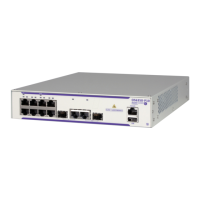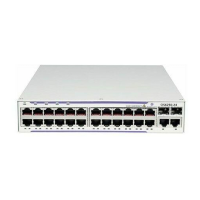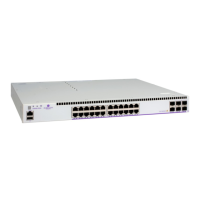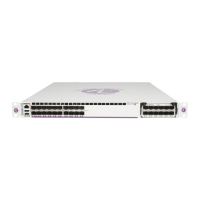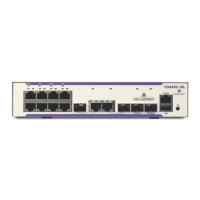Configuring Service Assurance Agent Service Assurance Agent Overview
OmniSwitch AOS Release 8 Network Configuration Guide December 2017 page 38-4
Service Assurance Agent Overview
The Service Assurance Agent (SAA) feature is used to send periodic ping or loopback tests to peers over
the network. This is done using standard IP ping packets, proprietary MAC pings, and Ethernet OAM
tests. It is possible to configure a large number of test sessions on the switch, with each test having the
ability to send notification traps and provide a method for determining network performance.
Each SAA test can specify threshold values for jitter and round-trip-time (RTT). When SAA processes an
iteration of a test session, it will compare the results against the following criteria to see if an SNMP trap
should be sent. A trap with the session name is sent if:
– At least one packet is lost.
– Warning: Average RTT/Jitter within 10% of threshold.
– Critical: Average RTT/Jitter at or above threshold.
When an SAA is created, an owner name is assigned to the agent. This name is based on the application
that generated the SAA. For example:
– CLI SAA owner name = “USER”
– OmniVista owner name = “OV”
– Shortest Path Bridging owner name = “SPB”
The SAA feature also provides the ability to periodically record the last five iterations of all SAA sessions
to an XML file on the local switch. The name of the XML file and the logging time interval are
configurable SAA XML parameters.
Configuring Service Assurance Agent
This section describes how to use OmniSwitch Command Line Interface (CLI) commands to configure
Service Assurance Agent (SAA) on a switch. Consider the following guidelines when configuring SAA
functionality:
• Creating an SAA ID is required before the SAA type is configured. This only applies to MAC ping, IP
ping, and Ethernet OAM SAAs. SAA IDs for OmniVista and SPB SAAs are automatically generated
by those applications.
• Any number of SAAs can be configured (MAX 127). It is recommended not to start many aggressive
SAAs (having session interval <= 10). To achieve proper scheduling of all the started SAA (aggressive
and relaxed) it is recommended not to start more than 50 SAAs.
• Once the configurable SAA session timer expires (or immediately when a start is done), the session is
added to the end scheduler linked list and the next session is scheduled. If there are other sessions
waiting for execution, the session is processed after the other sessions have finished (first-come-first-
serve). Only one session can be running a test at a time. An unlimited number of sessions can be
queued up on the list. Large numbers of sessions SAAs may not observe the exact interval time.
• If the destination MAC address is found on a link aggregate, the SAA traverses all paths of the link
aggregate. Each test iteration sends out multiple packets. SAA will send each packet over a different
link of the aggregate. This allows SAA to test all portions of the multi-path. Calculations of the delay
and jitter are available on a multi-link basis. This is only available for MAC pings.

